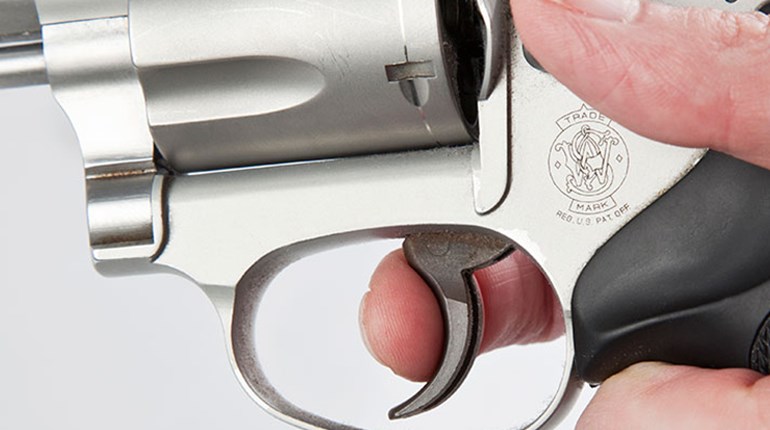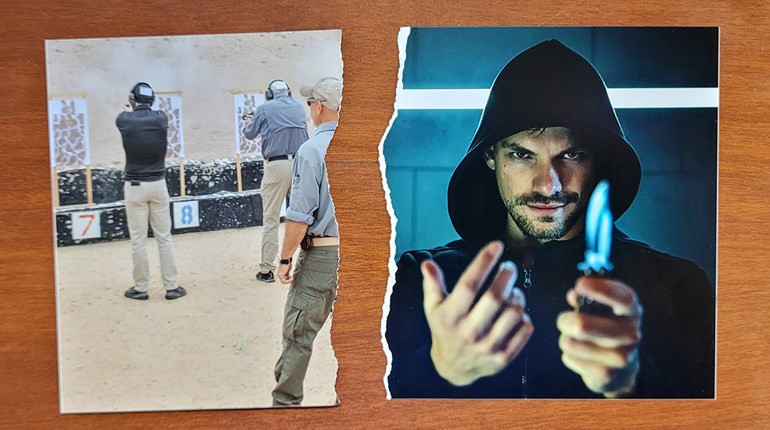
The Problem
After having had the desire to own a handgun for a long time, you finally took the plunge and bought a 9 mm semi-automatic pistol. After getting your new acquisition home, you suddenly realize that you have something you know little to nothing about. After reading the owner’s manual from cover to cover several times, you still don’t feel like you have sufficient knowledge to safely handle and use the pistol.
The Solution
In our classes we often comment, “do the unnatural thing, read the owner’s manual before handling the gun.” Owner’s manuals will cover safety, which is paramount in gun handling, as well as other important information about the gun, such as acceptable ammunition, nomenclature and maintenance.
There are many safety rules listed from a variety of sources, but two in particular should be kept in mind when handling any firearm: muzzle management and trigger-finger discipline.
The muzzle end of the barrel, where the bullet exits the gun, should be managed or controlled consciously at all times when handling a gun. Get in the habit of keeping the muzzle pointed in a safe direction at all times, whether or not you are pointing at a target. A safe direction can be any direction as long as no personal injury and minimal-to-no property damage would occur should discharge take place. It’s really easy if you think about it.
Trigger-finger discipline is simply maintaining a conscious awareness of where your trigger finger is at all times when handling a firearm. If there is no reason to have your finger on the trigger, extend it along the frame above the trigger guard until the trigger needs to be pulled. A frequently use catch phrase regarding trigger finger discipline is “on target on trigger, off target off trigger.”
Just to be clear, there are times when it is perfectly acceptable to pull the trigger of your pistol when it has been doubly verified as unloaded (chamber of the barrel and magazine well) and no ammunition is present in the firearm’s vicinity. For instance, after cleaning, lubricating and reassembling your pistol, it is a good idea to perform a function check to ensure that it is mechanically performing properly. This involves pulling the trigger to see if it is operating as expected. In addition, as you practice to improve your marksmanship skills, dry-fire drills will become an important part of your shooting routine. Dry-firing is practicing the mechanics involved in shooting with no ammunition in—or anywhere near—the gun. Again, this involves pulling the trigger on an empty gun, which will condition the finger to operate the trigger without adding movement to the gun.
Your manual will have names for all of the operating levers and buttons essential to the operation of the pistol and descriptions as to how they function. Once familiar with this information and the safety aspects previously mentioned, you are ready to handle the pistol to reinforce and experience what you have been reading.
A safety check of the pistol is something you should perform more than anything else, especially in the beginning stages of becoming familiar with and handling the gun. A normal routine for most semi-automatic pistols is to first remove the magazine, then lock the slide rearward so the chamber and magazine well can be visually and physically verified to be free of ammunition. Get in the habit of using the visual and kinesthetic senses in tandem when working with firearms. Not only does this help with safe handling, it will accelerate your marksmanship skills, as well.
Practice locking the slide to the rear with and without an empty magazine. Practice releasing the slide by depressing the slide-stop lever. Be aware this will be more difficult with an empty magazine in the pistol than not having one seated. Focus your practice without the magazine, as it will become more relevant to other aspects of your shooting as you move forward in your training.
 Simultaneously with the safety check and slide manipulation, practice a smooth insertion and release of an empty magazine in and out of the magazine well. Learn to actuate the magazine release with a thumb or finger from the shooting hand if possible.
Simultaneously with the safety check and slide manipulation, practice a smooth insertion and release of an empty magazine in and out of the magazine well. Learn to actuate the magazine release with a thumb or finger from the shooting hand if possible.
At this juncture, with a little practice, you should have sufficient handling skills to put the gun into operation and take it out of operation much like described in the owner’s manual.
I would like to recommend, however, that you learn to fieldstrip and maintain your pistol prior to going to the range, just to give added familiarity and confidence in handling. Fieldstripping and maintaining your pistol while it’s still clean will give you a better perspective of what needs attention after a trip to the range, as well.
There is a lot more to discuss, such as the basics of marksmanship and the many uses that your pistol has available to you, but this should keep you safe and give you a solid foundation to get started.
Try to find the time to take a few classes as soon as you are able. They will accelerate your progress and associate you with like-minded people, as well. In the meantime, practice your safety and handling skills often to keep them fresh in your mind when you visit the range.




































